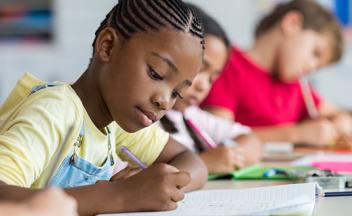Writing is thinking. When we write, we … organize, clarify, solidify understanding, build relationships, extend our thinking, and engage.
Joan Sedita, Keys to Literacy
Writing can be challenging for many students — there are so many skills and thinking processes that need to work in synch to produce effective, expressive writing.
Looking closely at a child’s writing allows us to discover what students know and have learned. We see what writing tools and techniques a student is experimenting with, and what the next steps for instruction might be. Our writing samples from real kids provide examples and next-step guidance for students from pre-K to third grade. Get started looking at — and thinking about — writing!
What you’ll find here
- Writing samples from real kids
- Advice about instruction based on samples
- Guidance on writing assessment
- Classroom strategies
- Writing resources
- Video about writing
Classroom strategies
In the classroom strategies section, we’ve gathered several strategies to support various stages of the writing process. Do your students need help organizing their writing? Sequencing the main events? Look here for strategies that support students’ writing.
Writing assessment
Teachers often struggle with writing assessment. Spelling and mechanical errors are obvious to see, and too often become the focus of the assessment. It’s important to consider other aspects of the sample and to include the writers themselves in the assessment process. Within this section you’ll find examples and suggestions for assessing writing for teachers and students.
A process approach to teaching writing
In school, writing typically uses a process approach. Students work with a piece of writing, and guide it through four general stages: prewriting, drafting, revising/editing, and publishing. The age of the student and the writing assignment may dictate how much time is spent in each stage. Teachers can use a combination of whole group, small group, and individual instruction within each stage of the process.
Featured video
Production credits
Looking at Writing was developed by Reading Rockets research director Dr. Joanne Meier and teacher-researcher Cathy Meaney.
Browse our writing resource library
Learn more about teaching writing and nurturing writing motivation with children through our articles, tips for parents, video, FAQs, and research briefs. Visit our Writing section
